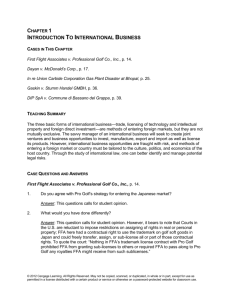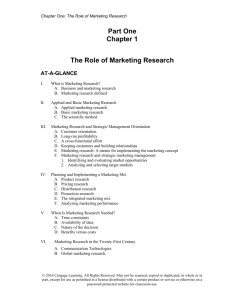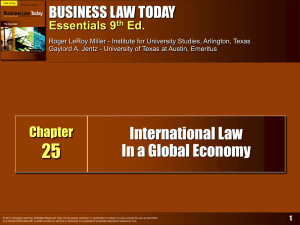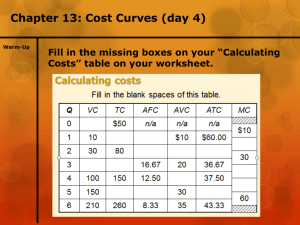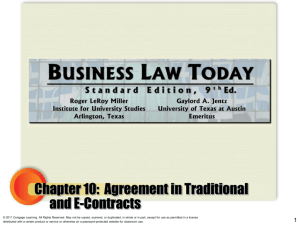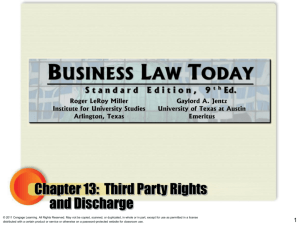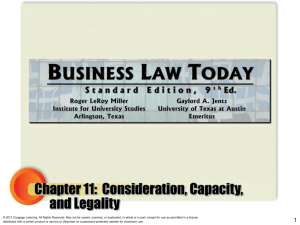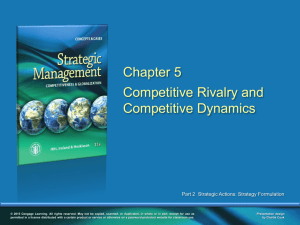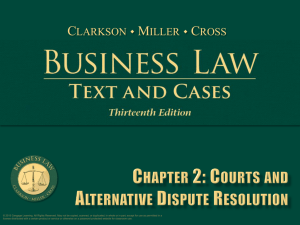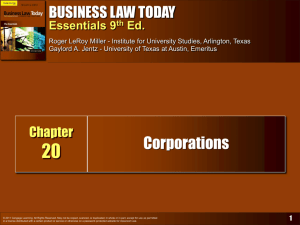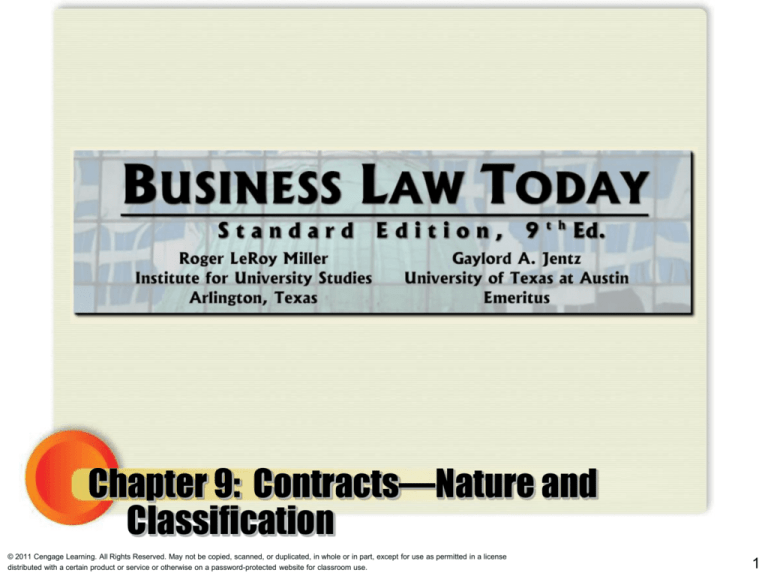
Chapter 9: Contracts—Nature and
Classification
© 2011 Cengage Learning. All Rights Reserved. May not be copied, scanned, or duplicated, in whole or in part, except for use as permitted in a license
distributed with a certain product or service or otherwise on a password-protected website for classroom use.
1
Learning Objectives
• What is a contract? What is the objective
theory of contracts?
• What are the four basic elements necessary
to a valid contract?
• What is the difference between an impliedin-fact and implied-in-law (quasi) contract?
• How does a void contract differ from a
voidable contract? What is an
unenforceable contract?
• What rules guide the courts in interpreting
contracts?
© 2011 Cengage Learning. All Rights Reserved. May not be copied, scanned, or duplicated, in whole or in part, except for use as permitted in
a license distributed with a certain product or service or otherwise on a password-protected website for classroom use.
2
An Overview of Contract Law
• Sources of Contract Law.
– Common law governs all contracts except
when modified by statutory law such as the
UCC.
• Function of Contracts:
– Fundamental to business.
– Creates rights and duties between parties.
– Provides stability and predictability.
• Parties: Promisor (makes the promise)
and Promisee (accepts the promise).
– Good faith in commercial agreements
© 2011 Cengage Learning. All Rights Reserved. May not be copied, scanned, or duplicated, in whole or in part, except for use as permitted in
a license distributed with a certain product or service or otherwise on a password-protected website for classroom use.
3
Definition of a Contract
• Agreement that can be enforced in
court.
• Formed by two or more parties.
• Failure to perform results in breach
and damages.
• Objective Theory of Contracts.
– Intent is interpreted by a reasonable person.
© 2011 Cengage Learning. All Rights Reserved. May not be copied, scanned, or duplicated, in whole or in part, except for use as permitted in
a license distributed with a certain product or service or otherwise on a password-protected website for classroom use.
4
Elements of a Contract
• A valid, enforceable contract includes:
– Agreement.
– Consideration.
– Capacity.
– Legality.
• Defenses to the Enforceability of a
Contract:
– Genuineness of Assent.
– Form.
© 2011 Cengage Learning. All Rights Reserved. May not be copied, scanned, or duplicated, in whole or in part, except for use as permitted in
a license distributed with a certain product or service or otherwise on a password-protected website for classroom use.
5
Contract Formation
© 2011 Cengage Learning. All Rights Reserved. May not be copied, scanned, or duplicated, in whole or in part, except for use as permitted in
a license distributed with a certain product or service or otherwise on a password-protected website for classroom use.
6
Bilateral vs. Unilateral Contracts
• Every contract has at least 2 parties:
the Offeror (Promisor) and the Offeree
(Promisee).
• Bilateral Contracts:
– Offeror and Offeree exchange promises to
each other.
– A contract is formed when Offeree promises
to perform.
© 2011 Cengage Learning. All Rights Reserved. May not be copied, scanned, or duplicated, in whole or in part, except for use as permitted in
a license distributed with a certain product or service or otherwise on a password-protected website for classroom use.
7
Bilateral vs. Unilateral Contracts
• Unilateral Contracts:
– Offeror wants performance in exchange for
his promise.
– Contract is formed when Offeree performs.
– Contests and lotteries are examples.
– Revocation of Offers for Unilateral Contracts:
modern view is that offer is irrevocable once
the Offeree substantially performs.
© 2011 Cengage Learning. All Rights Reserved. May not be copied, scanned, or duplicated, in whole or in part, except for use as permitted in
a license distributed with a certain product or service or otherwise on a password-protected website for classroom use.
8
Formal vs. Informal Contracts
• Formal: require special form or
method to be enforceable, e.g., under
seal.
• Informal: all other contracts.
© 2011 Cengage Learning. All Rights Reserved. May not be copied, scanned, or duplicated, in whole or in part, except for use as permitted in
a license distributed with a certain product or service or otherwise on a password-protected website for classroom use.
9
Express vs. Implied Contracts
• Express: terms of contract are set
forth either in writing or orally.
• Implied-in-Fact: based on conduct.
– Plaintiff furnished service or product.
– Plaintiff expects to be compensated.
– Defendant had a chance to reject and did
not.
Case 9.1 Uhrhahn Construction &
Design, Inc. v. Hopkins.
Parties created an enforceable implied-in-fact contract
when both parties waived the written requirement for
changes.
© 2011 Cengage Learning. All Rights Reserved. May not be copied, scanned, or duplicated, in whole or in part, except for use as permitted in
a license distributed with a certain product or service or otherwise on a password-protected website for classroom use.
10
Contract Performance
• Contract Performance: Executed vs.
Executory.
– Executed: fully performed by both sides.
– Executory: at least one of the parties has not
performed.
© 2011 Cengage Learning. All Rights Reserved. May not be copied, scanned, or duplicated, in whole or in part, except for use as permitted in
a license distributed with a certain product or service or otherwise on a password-protected website for classroom use.
11
Contract Enforceability
© 2011 Cengage Learning. All Rights Reserved. May not be copied, scanned, or duplicated, in whole or in part, except for use as permitted in
a license distributed with a certain product or service or otherwise on a password-protected website for classroom use.
12
Contract Enforceability
• Valid Contract.
– Four Elements: Agreement, Consideration,
Legal Purposes, Parties have legal capacity.
• Voidable Contract.
– Valid contract that is legally defective and
can be avoided (rescinded) by one of the
parties.
• Void Contract.
– No contract at all.
© 2011 Cengage Learning. All Rights Reserved. May not be copied, scanned, or duplicated, in whole or in part, except for use as permitted in
a license distributed with a certain product or service or otherwise on a password-protected website for classroom use.
13
Quasi Contracts
• Fictional, created by court to avoid
unjust enrichment.
• Limitations on Quasi-Contractual
Recovery.
• When an actual contract already
exists, quasi contract cannot be used.
© 2011 Cengage Learning. All Rights Reserved. May not be copied, scanned, or duplicated, in whole or in part, except for use as permitted in
a license distributed with a certain product or service or otherwise on a password-protected website for classroom use.
14
Interpretation of Contracts
• Plain Language Laws.
– If language is clear from face of contract,
court will enforce a contract according to
plain terms.
– If language clear, court cannot consider
extrinsic evidence.
© 2011 Cengage Learning. All Rights Reserved. May not be copied, scanned, or duplicated, in whole or in part, except for use as permitted in
a license distributed with a certain product or service or otherwise on a password-protected website for classroom use.
15
Rules of Interpretation
© 2011 Cengage Learning. All Rights Reserved. May not be copied, scanned, or duplicated, in whole or in part, except for use as permitted in
a license distributed with a certain product or service or otherwise on a password-protected website for classroom use.
16
Interpretation of Contracts
• Plain Meaning Rule.
– If language is clear from face of contract,
court will enforce a contract according to
plain terms.
– If language clear, court cannot consider
extrinsic evidence.
Case 9.2 Wagner v. Columbia Pictures
Industries, Inc.
Parties
created an enforceable implied-in-fact contract
.
when both parties waived the written requirement for
changes.
© 2011 Cengage Learning. All Rights Reserved. May not be copied, scanned, or duplicated, in whole or in part, except for use as permitted in
a license distributed with a certain product or service or otherwise on a password-protected website for classroom use.
17
Interpretation of Contracts
• Other Rules of Interpretation.
– What did the parties WRITE in the contract?
– Courts will generally not remake the contract
into what the parties’ claim their intent was
when they made the contract.
– Ordinary usage of terms.
– Trade Usage, Custom, Prior Dealings.
Case 9.3 U.S. Bank, N.A. v. Tennessee
Farmers Mutual Insurance Co.
Primary rule of interpretation is to give effect to the
intent of the parties. “Increase of hazard” did not include
commencement of foreclosure proceedings.
© 2011 Cengage Learning. All Rights Reserved. May not be copied, scanned, or duplicated, in whole or in part, except for use as permitted in
a license distributed with a certain product or service or otherwise on a password-protected website for classroom use.
18




